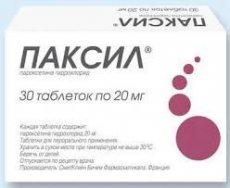Medical expert of the article
New publications
Preparations
Paxil
Last reviewed: 23.04.2024

All iLive content is medically reviewed or fact checked to ensure as much factual accuracy as possible.
We have strict sourcing guidelines and only link to reputable media sites, academic research institutions and, whenever possible, medically peer reviewed studies. Note that the numbers in parentheses ([1], [2], etc.) are clickable links to these studies.
If you feel that any of our content is inaccurate, out-of-date, or otherwise questionable, please select it and press Ctrl + Enter.

Paxil preparation (synonyms - Paroxetine, Paroxetine hydrochloride, Paroxin, Adapepress, Aktaparoxetine, Seroxat, Rexetin, etc.) refers to selective serotonin reuptake inhibitors - antidepressants of the SSRIs group.
 [1]
[1]
Indications Paxil
Indications for the use of this medication are such depressive states and mental disorders as:
- reactive depression;
- atypical depression:
- postpsychotic (post-schizophrenic) depression;
- post-traumatic depression;
- dysthymia (chronic subdepression);
- obsessive-compulsive disorder;
- n Sycotic disorders with attacks of anxiety and agoraphobia (fear of open space);
- panic attacks, social phobias.
Release form
Form release: coated tablets of 20 mg (blister).

Pharmacodynamics
The principle of the effect of Paxil, like all preparations of the SSRIs group, is based on the theory of the onset of depression due to a deficiency of the monoamine transmitter of the central nervous system of serotonin in the interneuronal synapses that conduct nerve impulses. The mechanism of the therapeutic effect of Paxil is due to the ability of the active substance of the drug - paroxetine hydrochloride - to selectively stop the reuptake of serotonin by presynaptic neurons that secrete it.
As a result, in the synaptic gap between the presynaptic and postsynaptic membranes, the level of free serotonin is significantly increased. This stimulates the serotonin receptors of the central nervous system and the peripheral nervous system, and the increase in serotonergic activity leads to timoanaleptic and sedative effects - improving mood, sleep and cognitive functions in depressive states and mental disorders, including suicidal thoughts.
Pharmacokinetics
The pharmacokinetics of Paxil (paroxetine hydrochloride) is non-linear, that is, increasing its dose leads to a disproportionate increase in the level of the drug in the blood. But long-term use of the drug does not cause a cumulative effect.
After taking Paxil inside, it is absorbed from the digestive tract; up to 96% of the active substance actively binds to blood plasma proteins.
Paxil (paroxetine hydrochloride) is transformed in the liver to inactive metabolites, which are excreted through the kidneys. The average half-life is 15-24 hours. After 6-7 days after the beginning of regular intake of this drug, its equilibrium concentration is reached. It should be noted that the level of Paxil concentration in patients aged 65 years and over can be much higher than in younger patients.

Dosing and administration
The standard single dose of Paxil is one tablet (20 mg); The tablet is taken whole once a day - in the morning, regardless of food.
If the treatment does not give positive results, the doctor can increase the dose to 40-50 mg per day, increasing the dosage by 10 mg per week. The optimal duration of the treatment course is 4 months.
With the withdrawal of Paxil, the dose should be reduced gradually - 10 mg per week.
 [10]
[10]
Use Paxil during pregnancy
Use Paksil during pregnancy is allowed only in exceptional cases - according to the prescription of the doctor and under his supervision. In late pregnancy Paksil is strictly contraindicated.
Side effects Paxil
Among the side effects of Paxil are: nausea, vomiting, headaches, lowering blood pressure, tachycardia, sleep disorders, loss of appetite, anxiety and anxiety, decreased libido, impotence.
Taking Paxil can also be accompanied by dry mouth, increased sweating, facial swelling, fainting, seizures, weight gain, problems with stool.
There is a possibility of the manifestation of "serotonin syndrome", which is expressed in such symptoms as overexcitation, abnormal behavior, confusion, involuntary jerking of the muscles of the limbs, fever. In this case, an urgent call of a doctor is needed.
In addition, during the first weeks of therapy, the patient may develop suicidal thoughts, for this reason, his condition should be constantly monitored.

Overdose
Overdose of Paxil leads to nausea, vomiting, dizziness, convulsions, urinary retention, cardiac arrhythmia. Maybe a coma. There is no special antidote against paroxetine hydrochloride. The measures to eliminate the effects of an overdose consist of rinsing the stomach, causing vomiting and taking adsorption agents.
Interactions with other drugs
Interactions Paxil with other drugs are as follows:
- It is incompatible with antidepressants-MAO inhibitors (monoamine oxidase),
- application simultaneously with preparations of St. John's wort, tramadol, lithium, dextromethorphan and dihydroergotamine leads to "serotonin syndrome"
- enhances the effect of drugs containing ethyl alcohol,
- increases the duration of bleeding with the simultaneous use of anticoagulant drugs.
Paxil can be used concurrently with anticonvulsants and hypnotics (according to indications).
Shelf life
Shelf life is three years from the date of issue.
 [18]
[18]
Attention!
To simplify the perception of information, this instruction for use of the drug "Paxil" translated and presented in a special form on the basis of the official instructions for medical use of the drug. Before use read the annotation that came directly to medicines.
Description provided for informational purposes and is not a guide to self-healing. The need for this drug, the purpose of the treatment regimen, methods and dose of the drug is determined solely by the attending physician. Self-medication is dangerous for your health.

